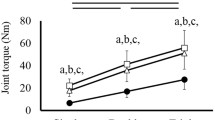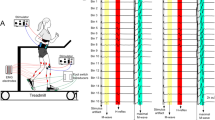Abstract
In experiments on isolated animal muscle, the force produced during active lengthening contractions can be up to twice the isometric force, whereas in human experiments lengthening force shows only modest, if any, increase in force. The presence of synergist and antagonist muscle activation associated with human experiments in situ may partly account for the difference between animal and human studies. Therefore, this study aimed to quantify the force–velocity relationship of the human soleus muscle and assess the likelihood that co-activation of antagonist muscles was responsible for the inhibition of torque during submaximal voluntary plantar flexor efforts. Seven subjects performed submaximal voluntary lengthening, shortening(at angular, velocities of +5, −5, +15, −15 and +30, and −30° s−1) and isometric plantar flexor efforts against an ankle torque motor. Angle-specific (90°) measures of plantar flexor torque plus surface and intramuscular electromyography from soleus, medial gastrocnemius and tibialis anterior were made. The level of activation (30% of maximal voluntary isometric effort) was maintained by providing direct visual feedback of the soleus electromyogram to the subject. In an attempt to isolate the contribution of soleus to the resultant plantar flexion torque, activation of the synergist and antagonist muscles were minimised by: (1) flexing the knee of the test limb, thereby minimising the activation of gastrocnemius, and (2) applying an anaesthetic block to the common peroneal nerve to eliminate activation of the primary antagonist muscle, tibialis anterior and the synergist muscles, peroneus longus and peroneus brevis. Plantar flexion torque decreased significantly (P<0.05) after blocking the common peroneal nerve which was likely due to abolishing activation of the peroneal muscles which are synergists for plantar flexion. When normalised to the corresponding isometric value, the force–velocity relationship between pre- and post-block conditions was not different. In both conditions, plantar flexion torques during shortening actions were significantly less than the isometric torque and decreased at faster velocities. During lengthening actions, however, plantar flexion torques were not significantly different from isometric regardless of angular velocity. It was concluded that the apparent inhibition of lengthening torques during voluntary activation is not due to co-activation of antagonist muscles. Results are presented as mean (SEM).






Similar content being viewed by others
References
Aagaard P, Simonsen EB, Trolle M, Bangsbo J, Klausen K (1996) Specificity of training velocity and training load on gains in isokinetic knee joint strength. Acta Physiol Scand 156:123–129
Aagaard P, Simonsen EB, Andersen JL, Magnusson SP, Bojsen-Moller F, Dyhre-Poulsen P (2000a) Antagonist muscle coactivation during isokinetic knee extension. Scand J Med Sci Sports 10:58–67
Aagaard P, Simonsen EB, Andersen JL, Magnusson SP, Halkjar-Kristensen J, Dyhre-Poulsen P (2000b) Neural inhibition during maximal eccentric and concentric quadriceps contraction: effects of resistance training. J Appl Physiol 89:2249–2257
Aimonetti JM, Vedel JP, Schmied A, Pagni S (2001) Changes in the tonic activity of wrist extensor motor units induced by stimulating antagonist group I afferents in humans. Exp Brain Res 141:21–32
Amiridis IG, Morlon B (1995) Activation of agonist and antagonist muscles during plantar flexion of the ankle. C R Seances Soc Biol Fil 189:1129–1135
Amiridis IG, Martin A, Morlon B, Martin L, Cometti G, Pousson M, Hoecke J van (1996) Co-activation and tension-regulating phenomena during isokinetic knee extension in sedentary and highly skilled humans. Eur J Appl Physiol 73:149–156
Arndt AN, Komi PV, Bruggermann G-P, Lukkariniemi J (1998) Individual muscle contributions to the in vivo Achilles tendon force. 13:532–541
Baratta R, Solomonow M, Zhou BH, Letson D, Chuinard R, D'Ambrosia R (1988) Muscular coactivation. The role of the antagonist musculature in maintaining knee stability. Am J Sports Med 16:113–122
Behm DG, Sale DG (1996) Influence of velocity on agonist and antagonist activation in concentric dorsiflexion muscle actions. Can J Appl Physiol 21:403–416
Benzon HT, Kim C, Benzon HP, Silverstein ME, Jericho B, Prillaman K, Buenaventura R (1997) Correlation between evoked motor response of the sciatic nerve and sensory blockade. Anesthesiology 87:547–552
Carpentier A, Duchateau J, Hainaut K (1996) Velocity-dependent muscle strategy during plantarflexion in humans. J Electromyogr Kinesiol 6:225–233
Cresswell AG, Loscher WN, Thorstensson A (1995) Influence of gastrocnemius muscle length on triceps surae torque development and electromyographic activity in man. Exp Brain Res 105:283–290
De Ruiter CJ, De Haan A (2001) Similar effects of cooling and fatigue on eccentric and concentric force–velocity relationships in human muscle. J Appl Physiol 90:2109–2116
Doorenbosch CA, Harlaar J, Ingen Schenau GJ van (1995) Stiffness control for lower leg muscles in directing external forces. Neurosci Lett 202:61–64
Dudley GA, Harris RT, Duvoisin MR, Hather BM, Buchanan P (1990) Effect of voluntary versus artificial activation on the relationship of muscle torque to speed. J Appl Physiol 69:2215–2221
Enoka RM (1996) Eccentric contractions require unique activation strategies by the nervous system. J Appl Physiol 81:2339–2346
Gregor RJ, Komi PV, Browning RC, Jarvinen M (1991) A comparison of the triceps surae and residual muscle moments at the ankle during cycling. J Biomech 24:289–297
Hageman P, Gillaspie D, Hill L (1988) Effect of speed and limb dominance on eccentric and concentric isokinetic testing of the knee. J Orthop Sports Phys Ther 10:59–65
Hagood S, Solomonow M, Baratta R, Zhou BH, D'Ambrosia R (1990) The effect of joint velocity on the contribution of the antagonist musculature to knee stiffness and laxity. Am J Sports Med 18:182–187
Jones KE, Lyons M., Bawa P, Lemon RN (1994) Recruitment order of motoneurones during functional tasks. Exp Brain Res 100:503–508
Katz B (1939) The relations between force and speed in muscular contraction. J Physiol (Lond) 96:45–64
Kellis E (1998) Quantification of quadriceps and hamstring antagonist activity. Sports Med 25:37–62
Kellis E, Baltzopoulos V (1997) The effects of antagonist moment on the resultant knee joint moment during isokinetic testing of the knee extensors. Eur J Appl Physiol 76:253–259
Kennedy PM, Cresswell AG (2001) The effect of muscle length on motor-unit recruitment during isometric plantar flexion in humans. Exp Brain Res 137:58–64
Lombardi V, Piazzesi G (1990) The contractile response during steady lengthening of stimulated frog muscle fibres. J Physiol (Lond) 431:141–171
Miaki H, Someya F, Tachino K (1999) A comparison of electrical activity in the triceps surae at maximum isometric contraction with the knee and ankle at various angles. Eur J Appl Physiol 80:185–191
Murray MP, Guten GN, Baldwin JM, Gardner GM (1976) A comparison of plantar flexion torque with and without the triceps surae. Acta Orthop Scand 47:122–124
Nardone A, Schieppati M (1988) Shift of activity from slow to fast muscle during voluntary lengthening contractions of the triceps surae muscles in humans. J Physiol (Lond) 395:363–381
Nardone A, Romano C, Schieppati M (1989) Selective recruitment of high-threshold human motor units during voluntary isotonic lengthening of active muscles. J Physiol (Lond) 409:451–471
Olney SJ, Winter DA (1985) Predictions of knee and ankle moments of force in walking from EMG and kinematic data. J Biomech 18:9-20
Osternig LR, Hamill J, Lander JE, Robertson R (1986) Co-activation of sprinter and distance runner muscles in isokinetic exercise. Med Sci Sports Exerc 18:431–435
Pinniger GJ, Steele JR, Thorstensson A, Cresswell AG (2000) Tension regulation during lengthening and shortening actions of the human soleus muscle. Eur J Appl Physiol 81:375–383
Pinniger GJ, Nordlund MM, Steele JR, Cresswell AG (2001) H-reflex modulation during passive lengthening and shortening of the human triceps surae. J Physiol (Lond) 534:913–923
Pousson M, Amiridis IG, Cometti G, Van Hoecke J (1999) Velocity-specific training in elbow flexors. Eur J Appl Physiol 80:367–72
Romano C, Schieppati M (1987) Reflex excitability of human soleus motoneurones during voluntary shortening or lengthening contractions. J Physiol (Lond) 390:271–284
Seger JY, Thorstensson A (2000) Electrically evoked eccentric and concentric torque-velocity relationships in human knee extensor muscles. Acta Physiol Scand 169:63–69
Snow CJ, Cooper J, Quanbury AO, Anderson JE (1993) Antagonist cocontraction of knee flexors during constant velocity muscle shortening and lengthening. J Electromyogr Kinesiol 3:78–86
Snow CJ, Cooper J, Quanbury AO, Anderson JE (1995) Antagonist cocontraction of knee extensors during constant velocity muscle shortening and lengthening. J Electromyogr Kinseiol 5:185–192
Solomonow M, Guzzi A, Baratta R, Shoji H, D'Ambrosia R (1986) EMG-force model of the elbows antagonistic muscle pair. The effect of joint position, gravity and recruitment. Am J Phys Med 65:223–244
Solomonow M, Baratta R, Zhou BH, D'Ambrosia R (1988) Electromyogram coactivation patterns of the elbow antagonist muscles during slow isokinetic movement. Exp Neurol 100:470–477
Stotz PJ, Bawa P (2001) Motor unit recruitment during lengthening contractions of human wrist flexors. Muscle Nerve 24:1535–1541
Westing SH, Seger JY (1989) Eccentric and concentric torque-velocity characteristics, torque output comparisons, and gravity effect torque corrections for the quadriceps and hamstring muscles in females. Int J Sports Med 10:175–180
Westing SH, Seger JY, Thorstensson A (1990) Effects of electrical stimulation on eccentric and concentric torque-velocity relationships during knee extension in man. Acta Physiol Scand 140:17–22
Acknowledgements
We would like to thank Dr. Condello for his help in performing the common peroneal nerve block. The Swedish Medical Research Council and Center for Sports Research funded this project. We would also like to thank the Swedish Institute and the International Society of Biomechanics for providing financial support for G.J. Pinniger.
Author information
Authors and Affiliations
Corresponding author
Rights and permissions
About this article
Cite this article
Pinniger, G.J., Steele, J.R. & Cresswell, A.G. The force–velocity relationship of the human soleus muscle during submaximal voluntary lengthening actions. Eur J Appl Physiol 90, 191–198 (2003). https://doi.org/10.1007/s00421-003-0893-4
Accepted:
Published:
Issue Date:
DOI: https://doi.org/10.1007/s00421-003-0893-4




